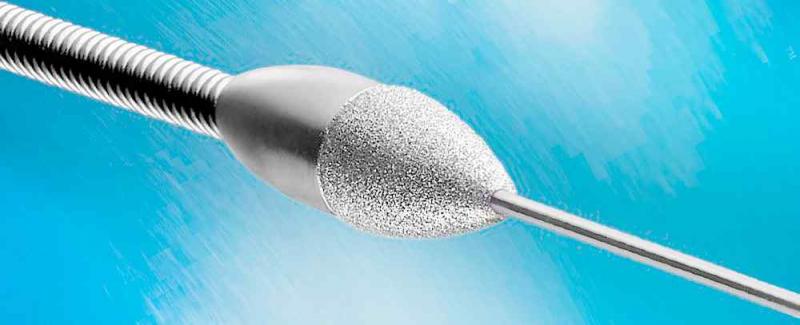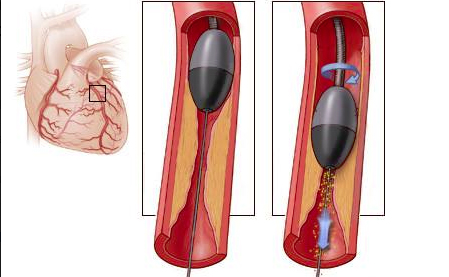In recent years numbers of cardiovascular diseases have been dramatically increased. Until recently invasive interventions such as angioplasty and stenting of coronary arteries considered as innovative methods of treatment of coronary diseases.
However angioplasty and stenting methods, as it has been proven by the experience of their use, has two main restrictions on use:
1. Internal wall dissections of extremely narrowed and calcified vessel (dissections) after its expansion, which may be expanded, violate the normal blood flow, cause thrombus formation and lead to the complete occlusion of the vessel.
2. High rate of re-stenosis, up to 30-40% occurs after angioplasty (from 2 to 6 months). Besides, the calcification of stenotic vessels is a contraindication for using these techniques.
The method of rotablation angioplasty has been effective for the treatment of calcified and therefore resistance for dilatation vessels.
Rotablator is a diamond-tipped, olive-shaped high speed drill, which is used for restoration of patency of the arteries with atherosclerotic calcified plaques. At introduction of the device to the field of stenosis of the coronary artery, the elliptical portion of the catheter head rotating at 180000 rpm, grinds atheroma into million tiny pieces. Unlike the direct atherectomy, rotablation allows to remove (destroy) the plaque immediately. Initial success is achieved in 95% of the cases. However, most of the patients are needed accompanying angioplasty to reach optimal vessel diameter. Contraindications for the method are thrombosis and increased angulation of the coronary artery.
Rotablator and rotational ablation of coronary atherosclerotic plaque
This technology has been recently acquired by MC Erebouni. In May 5th of 2016, for the first time in Armenia, in MC Erebouni, at the workshop with the participation of the Polish specialist, the head of Invasive Cardiology Department of Medical University of Belyastok Dr. Slavomir Dobzhicky was carried out intervention using rotablation technology.
Two patients with anterior ascending artery lesion have been operated during the workshop. Significant calcification in the area of atherosclerotic stenosis was the reason for the failure of previous procedures in both patients. Clinically they had exertional angina at minimal physical loading.
With the help of rotational atherectomy using the drills of different diameters, it was possible to expand the lumen of the arteries, and then the procedures have been completed by standard angioplasty and stenting with the drug - eluted stents.
The procedures went smoothly, without any complications. In a day both patients were discharged with symptomatic improvement. The implementation of rotablation angioplasty method into a cardiac clinical practice means salvation and improvement the quality of life of the patients with calcified stenosis of coronary arteries, when the standard methods of angioplasty are not effective, and in some cases are even contraindicated.




